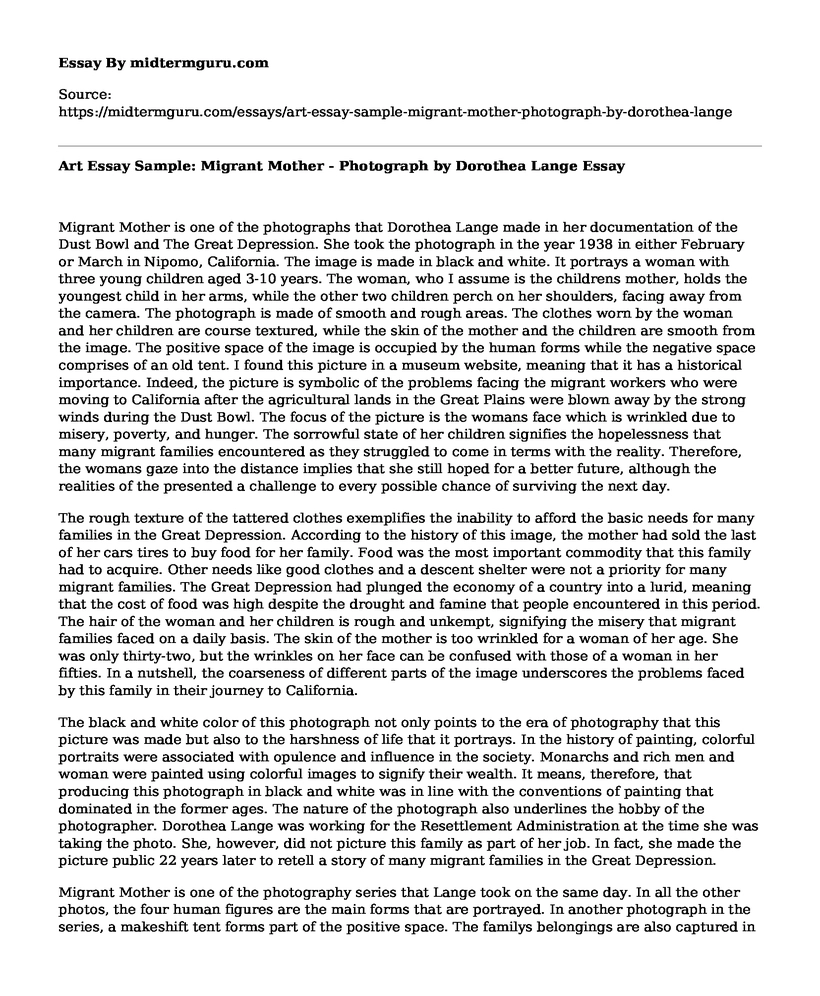Migrant Mother is one of the photographs that Dorothea Lange made in her documentation of the Dust Bowl and The Great Depression. She took the photograph in the year 1938 in either February or March in Nipomo, California. The image is made in black and white. It portrays a woman with three young children aged 3-10 years. The woman, who I assume is the childrens mother, holds the youngest child in her arms, while the other two children perch on her shoulders, facing away from the camera. The photograph is made of smooth and rough areas. The clothes worn by the woman and her children are course textured, while the skin of the mother and the children are smooth from the image. The positive space of the image is occupied by the human forms while the negative space comprises of an old tent. I found this picture in a museum website, meaning that it has a historical importance. Indeed, the picture is symbolic of the problems facing the migrant workers who were moving to California after the agricultural lands in the Great Plains were blown away by the strong winds during the Dust Bowl. The focus of the picture is the womans face which is wrinkled due to misery, poverty, and hunger. The sorrowful state of her children signifies the hopelessness that many migrant families encountered as they struggled to come in terms with the reality. Therefore, the womans gaze into the distance implies that she still hoped for a better future, although the realities of the presented a challenge to every possible chance of surviving the next day.
The rough texture of the tattered clothes exemplifies the inability to afford the basic needs for many families in the Great Depression. According to the history of this image, the mother had sold the last of her cars tires to buy food for her family. Food was the most important commodity that this family had to acquire. Other needs like good clothes and a descent shelter were not a priority for many migrant families. The Great Depression had plunged the economy of a country into a lurid, meaning that the cost of food was high despite the drought and famine that people encountered in this period. The hair of the woman and her children is rough and unkempt, signifying the misery that migrant families faced on a daily basis. The skin of the mother is too wrinkled for a woman of her age. She was only thirty-two, but the wrinkles on her face can be confused with those of a woman in her fifties. In a nutshell, the coarseness of different parts of the image underscores the problems faced by this family in their journey to California.
The black and white color of this photograph not only points to the era of photography that this picture was made but also to the harshness of life that it portrays. In the history of painting, colorful portraits were associated with opulence and influence in the society. Monarchs and rich men and woman were painted using colorful images to signify their wealth. It means, therefore, that producing this photograph in black and white was in line with the conventions of painting that dominated in the former ages. The nature of the photograph also underlines the hobby of the photographer. Dorothea Lange was working for the Resettlement Administration at the time she was taking the photo. She, however, did not picture this family as part of her job. In fact, she made the picture public 22 years later to retell a story of many migrant families in the Great Depression.
Migrant Mother is one of the photography series that Lange took on the same day. In all the other photos, the four human figures are the main forms that are portrayed. In another photograph in the series, a makeshift tent forms part of the positive space. The familys belongings are also captured in other photos. The baggage, the human figures, and the tent are representative of a typical family facing the harsh climatic and economic times in the 1930s. The photos are symbolic of people en route to better a destination with better living conditions, although no one among them is certain of the destination.
There is something that stands out as peculiar in this photo. No alone among the four people looks at the camera. Relatively, the woman is more orientated to the photographer as compared to the children. This arrangement can be interpreted in the context of the whole nation. These children had grown up amidst a harsh economy that deprived them of a normal upbringing as children. Their mother had seen better days before this catastrophe, and was ready to overcome the tribulations of the day. The children, on the other side, did not know any happiness in their lives. According to this photo, they were afraid of what lay ahead of them, which is probably why they faced away from the camera.
Cite this page
Art Essay Sample: Migrant Mother - Photograph by Dorothea Lange. (2021, Jun 04). Retrieved from https://midtermguru.com/essays/art-essay-sample-migrant-mother-photograph-by-dorothea-lange
If you are the original author of this essay and no longer wish to have it published on the midtermguru.com website, please click below to request its removal:
- Film Analysis Essay on A Decade Behind Bars: Return to the Farm
- Paper Example on Art and Architecture: Analysis of Buildings in New York
- Paper Example on New Registered Nurse Residence Program
- Essay Sample on The Embodiment of Self and the Dramaturgical Perspective
- Essay Sample on Prevention of Falls
- Cancer: Diagnosis, Treatment, and Debate - Research Paper
- Empowering Teen Cancer Patients: Foundation's Awareness Plan - Essay Sample







